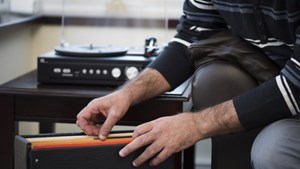A guide to estimating the value of your home contents
5 minute read

The cost of your contents insurance policy will depend on the total value of the contents of your home. You will need to provide your insurance company with an estimate of how much your possessions are worth so that you receive the correct pay-out if your home contents are damaged or stolen.

Get Home Insurance
Age Co helps homeowners over 50 find the right protection. We are 100% owned by Age UK and our profits go back to the charity.
Contents insurance can provide you with reassurance that the things you love are covered should the unexpected happen. However, the contents of your home could be more valuable than you think, so it’s vital to ensure you have adequate cover should you need to make a claim.
The cost of your contents insurance policy will depend on the total value of the contents of your home. You will need to provide your insurance company with an estimate of how much your possessions are worth so that you receive the correct pay-out if your home contents are damaged or stolen.
Overestimating the value of your possessions means you could end up paying a higher insurance premium, while underestimating how much your belongings are worth could mean you are left out of pocket if you need to make a claim, so it’s important to be as accurate as possible when it comes to calculating the value of your home contents.
How much are the contents of my home worth?
Estimating the value of your belongings can seem like a daunting task. However, ensuring you have a good understanding of what to include in the estimate and knowing how to accurately calculate the cost of your belongings will make the task much simpler.
Remember: Fixtures and fittings, such as the walls, windows and roofs, and items secured in place, like your kitchen cupboards, fitted wardrobes and bathroom suites, will all be covered under your buildings insurance policy. Therefore, they should be left out of your calculations.
What to include in your contents insurance estimate
The best way to ensure everything is covered is to make a list of all the items in each room of your home, including any belongings stored in the attic, shed, and any outbuildings. A good way to look at it is: if you could take the item with you if you were to move house, then it should be included in your estimate.
Here’s a breakdown of some of the most common items to include in your estimate:
Hallway
|
Lounge
|
Kitchen
|
Dining room
|
Bedroom(s)
|
Garden shed/garage
|
Calculating the cost of your belongings
Once you’ve made a list of all the belongings in each room of your home, you’ll need to work out their value. You could do this by using a contents insurance calculator. However, it’s just as easy to work out the total cost using good old-fashioned pen and paper.
Most contents insurance claims are settled on a ‘new for old’ basis, which means any items which are stolen or damaged will be replaced as new. This means you’ll need to calculate the cost of each item based on how much it would be to replace today, rather than the price you originally paid for it.
High value items
If you have any high value items, such as jewellery, antiques and heirlooms, it’s a good idea to have these valued by a professional and obtain a valuation certificate, particularly if they are especially rare or collectable. You should have these items revalued on a regular basis and update your insurance policy accordingly to ensure you receive the correct pay-out in the event of a claim.
Some insurers will limit the maximum amount they will pay-out for a single item, and so you will be required to give details of any particularly valuable items when you take out your policy. This is why it’s important to check the terms and conditions of your policy with your insurer, as you may find it cheaper to insure your higher value items separately.
Summary
To find the right level of contents insurance, it’s worth doing an estimate of the possessions in your house. Here are some useful tips to keep in mind:
- Start by making a list of items in each room of your home, including any those stored in the attic, shed, and any outbuildings.
- Try to estimate how much would be needed to replace each item today, rather than trying to remember the price you originally paid for it.
- For high-value items, such as jewellery, you might find it helpful to get a valuation from a professional.
- Fixtures and fittings, such as built-in wardrobes, should be left out of your calculations as they will be covered by buildings insurance.
For more information, specific to your policy, we recommend reaching out to your provider with any questions you may have.

Sign up to the Age Co Newsletter
Each month, our email newsletter delivers inspiring stories, practical guides to later life, plus the latest news about Age Co and the charitable work we support.
